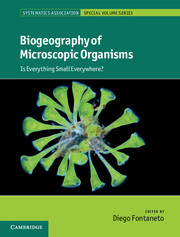Book contents
- Frontmatter
- Contents
- List of contributors
- Preface
- Part I Theoretical framework
- Part II Prokaryotes
- Part III Unicellular eukaryotes
- Part IV Pluricellular eukaryotes
- 9 Coalescent analyses reveal contrasting patterns of intercontinental gene flow in arctic-alpine and boreal-temperate fungi
- 10 Biogeography and phylogeography of lichen fungi and their photobionts
- 11 Biogeography of mosses and allies: does size matter?
- 12 Dispersal limitation or habitat quality – what shapes the distribution ranges of ferns?
- 13 Ubiquity of microscopic animals? Evidence from the morphological approach in species identification
- 14 Molecular approach to micrometazoans. Are they here, there and everywhere?
- Part V Processes
- Index
- Systematics Association Publications
- Systematics Association Special Volumes
- Plate section
- References
11 - Biogeography of mosses and allies: does size matter?
from Part IV - Pluricellular eukaryotes
Published online by Cambridge University Press: 05 August 2012
- Frontmatter
- Contents
- List of contributors
- Preface
- Part I Theoretical framework
- Part II Prokaryotes
- Part III Unicellular eukaryotes
- Part IV Pluricellular eukaryotes
- 9 Coalescent analyses reveal contrasting patterns of intercontinental gene flow in arctic-alpine and boreal-temperate fungi
- 10 Biogeography and phylogeography of lichen fungi and their photobionts
- 11 Biogeography of mosses and allies: does size matter?
- 12 Dispersal limitation or habitat quality – what shapes the distribution ranges of ferns?
- 13 Ubiquity of microscopic animals? Evidence from the morphological approach in species identification
- 14 Molecular approach to micrometazoans. Are they here, there and everywhere?
- Part V Processes
- Index
- Systematics Association Publications
- Systematics Association Special Volumes
- Plate section
- References
Summary
Introduction
Bryophytes are the second largest group of embryophytes, or green land plants, after the very diverse Angiosperms. They comprise three main lineages (Frey, 2009; Goffinet and Shaw, 2009): mosses (Division or Phylum Bryophyta), that are currently estimated to include 12 500–13 000 species; liverworts (Marchantiophyta), that are thought to number 5000 or a few more; and hornworts (Anthocerotophyta), with only 100–150 species. This adds up to around 18 000 species, although estimates range from 14 000 to 25 000.
Bryophytes in general, and especially mosses and liverworts, are highly successful plants. They display a high level of diversity, are almost universally present in land environments, and play a significant role in many terrestrial and freshwater ecosystems (Vanderpoorten and Goffinet, 2009). Although often inconspicuous, mosses and liverworts can be found even in the world's toughest environments, such as freezing and hot deserts. Moreover, in some harsh environments, such as the epiphytic stratum of temperate woodlands or the terrestrial ecosystems of the tundra, they are the chief group of organisms, together with lichens. Peatlands, which cover c. 3% of the Earth's land surface (Limpens et al., 2008), are a particular and outstanding case of habitat where bryophytes generally prevail, commonly with species of Sphagnum as the dominant vegetation element. Even if bryophytes are particularly diverse and luxuriant in tropical montane cloud forests and in humid temperate woodlands, they can be found more or less abundantly in all environments where land plants can survive (Gignac, 2001).
- Type
- Chapter
- Information
- Biogeography of Microscopic OrganismsIs Everything Small Everywhere?, pp. 209 - 233Publisher: Cambridge University PressPrint publication year: 2011
References
- 34
- Cited by



